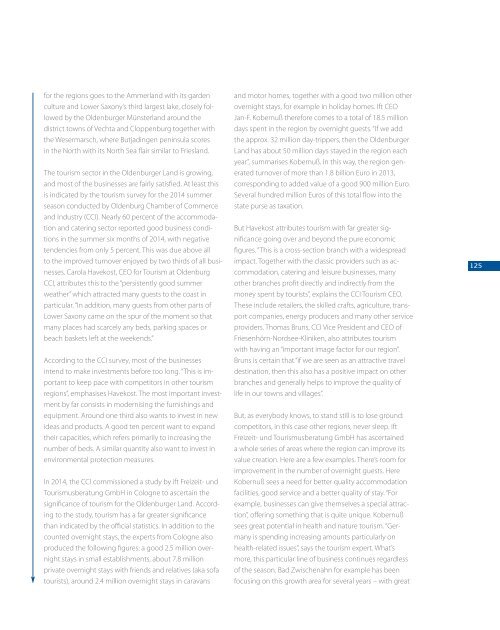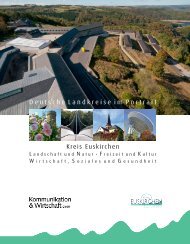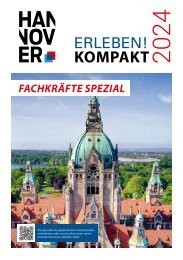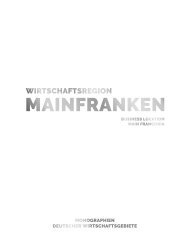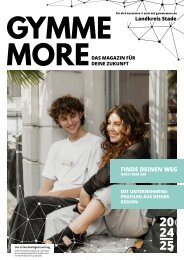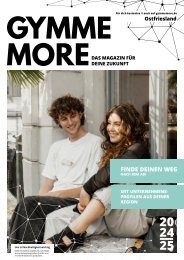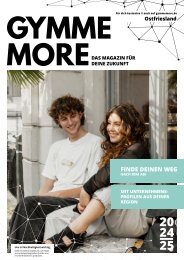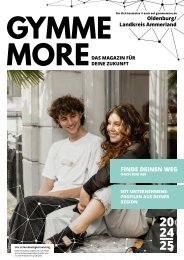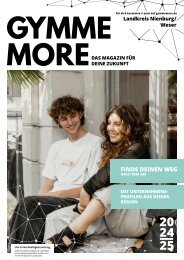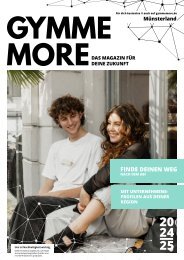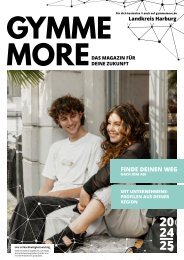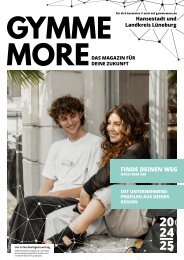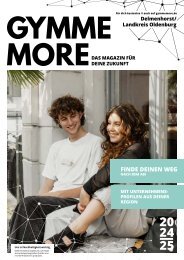Wirtschaftsstandort Oldenburg
You also want an ePaper? Increase the reach of your titles
YUMPU automatically turns print PDFs into web optimized ePapers that Google loves.
for the regions goes to the Ammerland with its garden<br />
culture and Lower Saxony’s third largest lake, closely followed<br />
by the <strong>Oldenburg</strong>er Münsterland around the<br />
district towns of Vechta and Cloppenburg together with<br />
the Wesermarsch, where Butjadingen peninsula scores<br />
in the North with its North Sea flair similar to Friesland.<br />
The tourism sector in the <strong>Oldenburg</strong>er Land is growing,<br />
and most of the businesses are fairly satisfied. At least this<br />
is indicated by the tourism survey for the 2014 summer<br />
season conducted by <strong>Oldenburg</strong> Chamber of Commerce<br />
and Industry (CCI). Nearly 60 percent of the accommodation<br />
and catering sector reported good business conditions<br />
in the summer six months of 2014, with negative<br />
tendencies from only 5 percent. This was due above all<br />
to the improved turnover enjoyed by two thirds of all businesses.<br />
Carola Havekost, CEO for Tourism at <strong>Oldenburg</strong><br />
CCI, attributes this to the “persistently good summer<br />
weather” which attracted many guests to the coast in<br />
particular. “In addition, many guests from other parts of<br />
Lower Saxony came on the spur of the moment so that<br />
many places had scarcely any beds, parking spaces or<br />
beach baskets left at the weekends.”<br />
According to the CCI survey, most of the businesses<br />
intend to make investments before too long. “This is important<br />
to keep pace with competitors in other tourism<br />
regions”, emphasises Havekost. The most important investment<br />
by far consists in modernising the furnishings and<br />
equipment. Around one third also wants to invest in new<br />
ideas and products. A good ten percent want to expand<br />
their capacities, which refers primarily to increasing the<br />
number of beds. A similar quantity also want to invest in<br />
environmental protection measures.<br />
In 2014, the CCI commissioned a study by ift Freizeit- und<br />
Tourismusberatung GmbH in Cologne to ascertain the<br />
significance of tourism for the <strong>Oldenburg</strong>er Land. According<br />
to the study, tourism has a far greater significance<br />
than indicated by the official statistics. In addition to the<br />
counted overnight stays, the experts from Cologne also<br />
produced the following figures: a good 2.5 million over -<br />
night stays in small establishments, about 7.8 million<br />
private overnight stays with friends and relatives (aka sofa<br />
tourists), around 2.4 million overnight stays in caravans<br />
and motor homes, together with a good two million other<br />
overnight stays, for example in holiday homes. Ift CEO<br />
Jan-F. Kobernuß therefore comes to a total of 18.5 million<br />
days spent in the region by overnight guests. “If we add<br />
the approx. 32 million day-trippers, then the <strong>Oldenburg</strong>er<br />
Land has about 50 million days stayed in the region each<br />
year”, summarises Kobernuß. In this way, the region gen -<br />
erated turnover of more than 1.8 billion Euro in 2013,<br />
corresponding to added value of a good 900 million Euro.<br />
Several hundred million Euros of this total flow into the<br />
state purse as taxation.<br />
But Havekost attributes tourism with far greater sig -<br />
nificance going over and beyond the pure economic<br />
figures. “This is a cross-section branch with a widespread<br />
impact. Together with the classic providers such as ac -<br />
commodation, catering and leisure businesses, many<br />
other branches profit directly and indirectly from the<br />
money spent by tourists”, explains the CCI Tourism CEO.<br />
These include retailers, the skilled crafts, agriculture, transport<br />
companies, energy producers and many other service<br />
providers. Thomas Bruns, CCI Vice President and CEO of<br />
Friesenhörn-Nordsee-Kliniken, also attributes tourism<br />
with having an “important image factor for our region”.<br />
Bruns is certain that “if we are seen as an attractive travel<br />
destination, then this also has a positive impact on other<br />
branches and generally helps to improve the quality of<br />
life in our towns and villages”.<br />
But, as everybody knows, to stand still is to lose ground:<br />
competitors, in this case other regions, never sleep. ift<br />
Freizeit- und Tourismusberatung GmbH has ascertained<br />
a whole series of areas where the region can improve its<br />
value creation. Here are a few examples. There’s room for<br />
improvement in the number of overnight guests. Here<br />
Kobernuß sees a need for better quality accommodation<br />
facilities, good service and a better quality of stay. “For<br />
example, businesses can give themselves a special attraction”,<br />
offering something that is quite unique. Kobernuß<br />
sees great potential in health and nature tourism. “Germany<br />
is spending increasing amounts particularly on<br />
health-related issues”, says the tourism expert. What’s<br />
more, this particular line of business continues regardless<br />
of the season. Bad Zwischenahn for example has been<br />
focusing on this growth area for several years – with great<br />
125


